
Known for their long beaks, distinctive drumming, and hard heads, woodpeckers are one of the most common forest birds sighted in Rock Creek Park. They serve an important ecological role in both the creation of cavity nests and the decomposition of dead trees. Their thick skulls, strong beaks, and powerful neck muscles allow them to deliver sharp blows that can create deep cavities which are used for food and for nests, both by the woodpeckers and other cavity nesting birds.
Nest holes are precious turf for cavity nesting birds and disputes over nest area is fairly common. Smaller birds are often booted from their chosen home, especially by the aggressive European Starlings who have even been known to boot the larger Red-bellied Woodpeckers from their newly excavated (or newly stolen) cavities. This is a serious issue, especially for birds who are not capable of making a new home.
Washington, DC has seven native woodpeckers all of whom, with the exception of the Yellow-bellied Sapsucker, live here year round. They are: Pileated Woodpeckers, Northern Flickers, Red-bellied Woodpeckers, Red-headed Woodpeckers, Hairy Woodpeckers, Downy Woodpeckers, and Yellow-bellied Sapsuckers.
At nearly the size of a crow, Pileated Woodpeckers are the largest woodpeckers in our area. Their loud drumming reverberates through wooded areas as they hack deep into the dead wood of standing or fallen trees.
Northern Flickers are slightly smaller than Pileated Woodpeckers. Although they are capable of climbing tree trunks and hunting for insects like other woodpeckers, Northern Flickers are most often seen on the ground digging in the dirt for ants, their most desirable food source.
Red-bellied, Red-headed, and Hairy Woodpeckers are all approximately the same size. Red-bellied and Red-headed Woodpeckers are two of only four woodpeckers in the North America known to store food, hiding insects and seeds under bark and roof shingles, in fence posts, and in cracks and crevices in trees, logs, and other wooden objects.
Downy Woodpeckers and their larger lookalike Hairy Woodpeckers can be usually be found close together throughout most of their ranges. Downy Woodpeckers tend to use the smaller decentralized branches to hunt for food while Hairy Woodpeckers use the trunk.
Yellow-bellied Sapsuckers, whose size is somewhere between that of the Downy and Hairy Woodpecker, use their beaks to drill into tree trunks for sap. When given a choice, they prefer to use tree species whose sap has a high sugar concentrations (such as: paper birch, yellow birch, sugar maple, red maple, and hickory).
Although all have their own distinct characteristics and chosen hunting grounds, woodpeckers will often hunt on the same tree, either at the same time or one after another. The feeding excavations of the larger woodpeckers, such as the Pileated Woodpecker, tends to attract other birds and other woodpeckers who will forage on the branches and catch insects on the leaves and bark that are scared by the woodpeckers drumming or explore the newly excavated holes for small bugs the large woodpecker may have missed.
City Wildlife sees more Northern Flickers than any other woodpeckers. We also see Red-bellied Woodpeckers, Downy Woodpeckers, and Yellow-bellied Sapsuckers. Most have sustained injuries from window collisions or from cat attacks.
The best things you can do to help local woodpeckers are:
- Keep your cats indoors!
- Put up bird tape or decals to prevent bird from striking windows.
- When using decals make sure you create a pattern that covers windows uniformly. Birds are use to flying through tree branches so if the decals are too far apart they will try to fly through them. Decals should be arranged in columns that are four inches apart and rows that are to inches apart. This is often called the 2 x 4 Rule.
- Turn off lights at night to prevent bird from colliding with windows.
- Put out bird feeders with sunflower seeds, crushed peanuts, apples, oranges, melon seeds, and suet.
For more information, take a look at the American Bird Conservancy’s website.

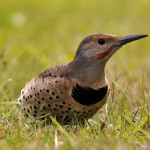
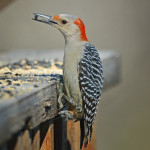
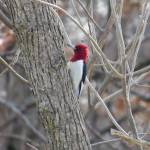
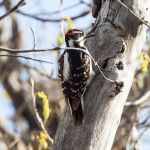
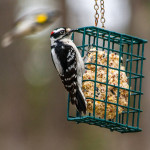
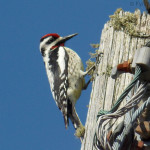


Thank you. There is one tapping in Ledroit Park and wanted to know why.
Instead of singing to establish their territories, woodpeckers hammer on tree branches, gutters, fences, or whatever else they can use to make some noise.